Maison Bâtard is Melbourne’s latest dining venture by a hospitality power couple
Melbourne restaurateur Chris Lucas has teamed up with his stylish wife Sarah for the first time on this lavish labour of love.
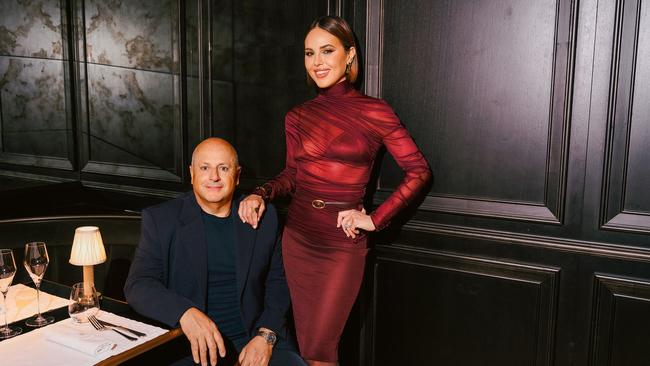
It’s a drizzly Friday in Sydney when WISH meets restaurateur Chris Lucas and his fashionable wife Sarah at their bright, modern, art-filled Point Piper bolthole. We’re here to discuss the couple’s latest and most ambitious opening yet, Melbourne’s new four-storey French hospitality haven, Maison Bâtard.
Chris is just back from the opening of Carlotta, his first Canberra restaurant, the night before. Meanwhile Sarah, this morning eschewing her signature black runway wardrobe for a tan Saint Laurent blazer and jeans, is farewelling the house guests that accompanied her to the Sydney wedding of stylist Caroline Tran and James Sturrock the previous evening.
“You’re not allowed to wear black in Sydney,” jests her husband, the respected hospitality baron known for dining institutions Society, Chin Chin, Kisumé, and today sporting head-to-toe navy Prada.
The eight-year, $45 million project named after one of Chris’s favourite French vineyards (“It’s 2000 years old and it makes some of the most revered white wine in the world”) is the restaurateur’s 13th opening but the couple’s first project working together. It is also lovingly modelled as an extension of their primary home in Melbourne’s Toorak.
Maison Bâtard is inspired by the couple’s travels throughout France and Chris’s lifelong vision to create a venue that blends a European elegance with unmistakeably Melbourne flair. It serves up a fresh spin on the traditional French brasserie on the ground floor, a first-floor salon restaurant complete with vaulted ceilings, a Parisian-inspired rooftop terrace planted by Paul Bangay and a decadent basement supper club.
The all-day destination is within the Bourke Hill precinct, known as the Paris end of Melbourne and a place rich with hospitality history. It was here that the Codognotto family operated The Italian Society from 1932, which inspired Chris’s 80 Collins Street restaurant of the same name. Maison Bâtard may be a Gallic wunderkammer but it is anything but thematic.
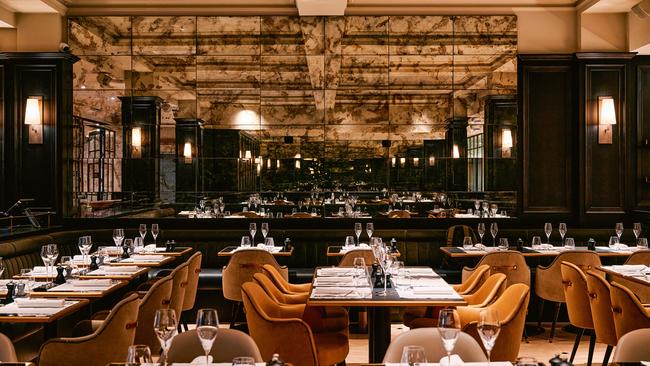
“I don’t think anything that Chris does is,” says Sarah, who is behind Maison Bâtard’s timeless design. “I didn’t want anything to look prefabricated or faux,” she says of the decision to go exclusively vintage or bespoke. “I want it to feel like my home, which really it does.”
“Collaborating with Sarah has allowed me to see design in a new way,” continues her husband. “Her aesthetic has pushed me to think differently and the result is a space that is not only beautiful but personal. It feels like an extension of our own lives.”
As it happens, many of Maison Bâtard’s interior gems come via their home. “A few bits and pieces are missing,” smiles Chris. Most notably, a gilded Louis XVIII lamp that now welcomes guests at the host’s desk, along with the 18th-century chandelier Sarah found on Milan’s Via Monte Napoleone seven years ago that now crowns the dining room. “It’s definitely a piece I was loath to get rid of, but I also want to see it in a space where it’s going to be really appreciated,” she smiles.
“This is very personal, it’s been purely approached from an aesthetic, design and artistic sense,” Chris says. “The commerciality side of it is secondary, and that’s why it’s cost so much! Far more than one could have ever imagined. But it’s legacy building; there’s no compromise here. This has pushed the boat out. And I don’t think they’ll have seen anything like this in Australia before.”
These days being a successful restaurateur often involves pairing hospitality with property development and this is also the case with Maison Bâtard. “The property element makes it really interesting, because owning the buildings gives you total control over the outcomes, no compromise, a real commitment to quality,” Chris adds of the site’s trio of buildings, acquired one at a time. “It took a bit of going … it started as a smaller concept, but I quickly realised it couldn’t work without the other buildings.”
That said, he does not see Maison Bâtard as part of the multi-floor hospitality complex model currently trending: Justin Hemmes’s Merivale plans to rejuvenate an area of Sydney’s CBD formerly known as Kings Green with a proposed 16,300-square-metre hotel and restaurant precinct, while Shell House’s Brett and Anna Robinson recently opened The International, spread across three floors of Sydney’s MLC Centre.
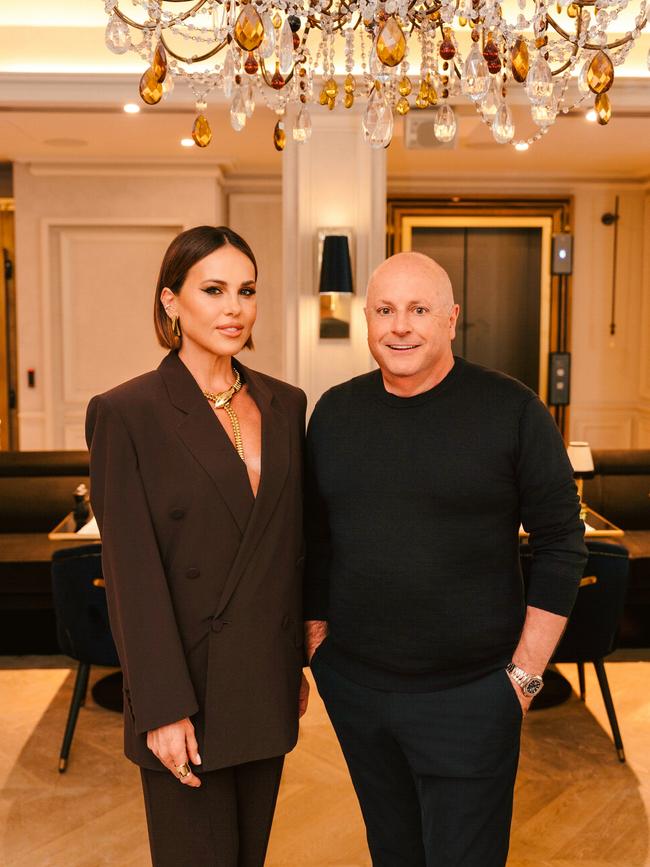
Instead Chris likens this demand to the real need for new social clubs as RSLs become gaming venues, local pubs are lost to soaring inner-city land values and nightclubs are wiped out by truncated licenses.
“My view is restaurants are the new social hub. But it doesn’t mean to say it has to be a fine-dining experience … far from it. I think it’s taking these meeting places and saying, ‘OK, how do we transition? How do we take food and amazing cocktails and then evolve it into an even bigger idea?’. This is where you see the convergence of hotels, restaurants, even beach clubs in Europe.”
Europe is also where the idea of Maison Bâtard first sprouted wings. “Sarah and I spent a lot of time travelling, having fun, going to flea markets, art galleries and basically turned that into a restaurant. It might sound a bit frivolous but travelling does open your eyes to so many different things,” Chris says.
“I’ve always been a bit of a Francophile. For me, it became an even bigger passion because I’m a big wine collector. With all the restaurants it’s always been a centrepiece of what I do.”
The people, flair, style and art of the great European wineries, alongside the fruits of their labours continue to inspire him. “You meet amazing people. I remember once we went to Château Margaux, which is owned by a Greek shipping heiress whose father bought the château as the first non-Frenchman to own a First Growth. With it they inherited this amazing art collection because in the old days artists like Picasso would come in,” he says.
“I remember at Pétrus, I’m sitting in the dining room and there’s Picassos everywhere. I went to the toilet and there was a Francis Bacon and Rodins just scattered through the garden like they were pieces of furniture.
“I said, ‘Oh, you’ve got an amazing collection here’. They said, ‘Oh no, you haven’t really seen the collection’. They took me down to the cellar: there must’ve been 150 Francis Bacons down there. And I said, ‘How did you collect all this?’. They said, ‘He used to come by and we’d give him a case of Pétrus and he’d give us a painting’. Of course, now those paintings are worth more than the estate.”
Sarah, meanwhile, drew her inspiration from French design heavyweights Joseph Dirand, Christian Liaigre, Jacques Garcia – the latter two recently uniting on the extension of Paris’s famed Hôtel Costes. Old-school classic French bistros, such as Paris’s La Fontaine de Mars and Allard also left an impression.
“We don’t just pop in and out of Paris. We spend weeks there,” she says of her sourcing trips that included the 18th-century gilt mirror that sits atop a grand stone fireplace in the venue and vintage Jacques Garcia lights initially discovered in Clignancourt and later purchased on 1stDibs as the pandemic set in.
“It’s not about being cool, it’s about being authentic, and that’s where the magic happens,” she says.
“Design, to me, like fashion, it’s about discovery and finding pieces that speak to you.”
Structurally they worked with Mills Gorman Architects to restore the façade and reconfigure the internal floorplan. “We had a very significant heritage compliancy as you can imagine,” recalls Chris. “So we got through that bureaucracy and then covid hit. There’s always deadlines. And planning restrictions. But all that went away during covid. Even the bank never bothered us. I think that gave us a very unique opportunity to dig deep and go, ‘OK, what can this really be?’ And that’s where we went from a single to a four-level building.”
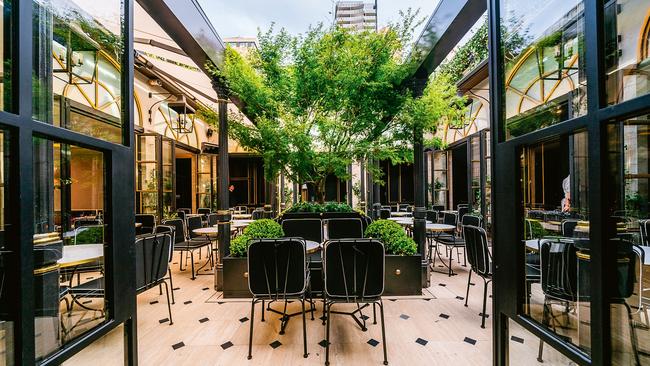
These days the couple has relocated the decision-making epicentre from the lounge at home to the Lucas offices.
“Well, she detours through Saint Laurent because unfortunately, the store is very close to the office,” laughs Chris, adding, “We do all the fun stuff together, which I think is really cool.
“Sarah doesn’t need to be worried about the commercial stuff, and I don’t want her to be. It’s like with my chefs: I put in place a lot of infrastructure to allow the creative to be creative. I hate it when chefs are bogged down doing paperwork, which I think takes away from their ability to think and create. And I do the same thing myself. I try to leave the day-to-day stuff to other people, and just spend more time thinking about what can be, what’s possible and drawing inspiration.”
Enabling a feeling of flow is just as important for his guests. “I create as few barriers as possible. I don’t set up all these rules. This is like a maison. You’ll come in, you’ll be greeted, and you’ll be given the run of the house – that European sensibility. So, if you’re upstairs and you’re having dinner and you want to come down and have a drink, no problem. We’re certainly not timing you out. I hate that. It’ll suit your moods,” Chris says.
It’s also why he hasn’t followed the model of a private members’ club. “In London, this would be a private club, but I don’t think [that’s] very Australian. Private clubs are all about rules and exclusion.”
The rich heritage of the location also informed this decision. “For Italian family the Codognottos, it was all about hospitality,” he says of one of Melbourne’s first a la carte restaurants complete with bow-tied waiters. Maison Bâtard has them, too.
“Of course, Canberra was [formerly] located in Melbourne on Spring Street. That was the national government. So, the Bourke Hill precinct is a really historical precinct, home to prime ministers and statesmen. And then, it had this flurry of amazing restaurants.”
“By the way, you weren’t allowed to serve alcohol in restaurants in Melbourne up until the ’60s,” Chris adds, smiling.
“[The Codognottos’] restaurant was very famous for giving you the wine for free but putting the cost of your chicken parmigiana up a few dollars.”
The food and wine of Maison Bâtard is under the direction of executive chef Adam Sanderson and sommelier Loïc Avril. “I’ve brought my very best, most-experienced staff here. One of my hosts has been with me for the best part of 30 years, he knows everyone in Melbourne by their first names. He even knows all the guests from Sydney, too,” Chris says.
The food is “light Mediterranean, French, but French with a modern sensibility. So very little cream, very little butter! I have a bit of a running joke with [French-Australian chef] Guillaume [Brahimi] because we always stir each other up a little bit when he posts food with layers of butter. ‘Go easy on the butter,’ I say, and he says, ‘No, you cannot cook French food without butter!’. So ours is more of a rustic, provincial cuisine: simple grilled fish, fresh herbs, citrus flavours, olive oil. Freshness is the key. Although, there’ll be some butter,” he smiles.
The Lucases may travel far and wide for work (and pleasure), but their meeting was a far more domestic affair. It happened some 14 years ago on the school run.
“He was driving past me, I was taking my little kids to school and he was dropping off one of his kids. And through a mutual friend he managed to get my number,” recalls Sarah. The meeting happened around the same time Chris was opening Chin Chin. “He invited me with a group of friends very casually, and then some time passed, and I thought, ‘Oh, he’s not interested’, and then we connected maybe two weeks later. He wanted to go out for lunch. And I was a bit standoffish, thinking, ‘Do I go? Do I not?’. I was like, ‘I’m just going to go and then I’m going to tell him I’m not interested’.”
Eleven hours later they were still chatting in St Kilda’s Café Di Stasio.
“We’d both been married before so we weren’t really in a rush,” says Chris.
“I think three or four years later we got engaged, but it was for our children, especially my children being younger, to show them a sense of having faith in the institution of marriage and to set an example,” shares Sarah.
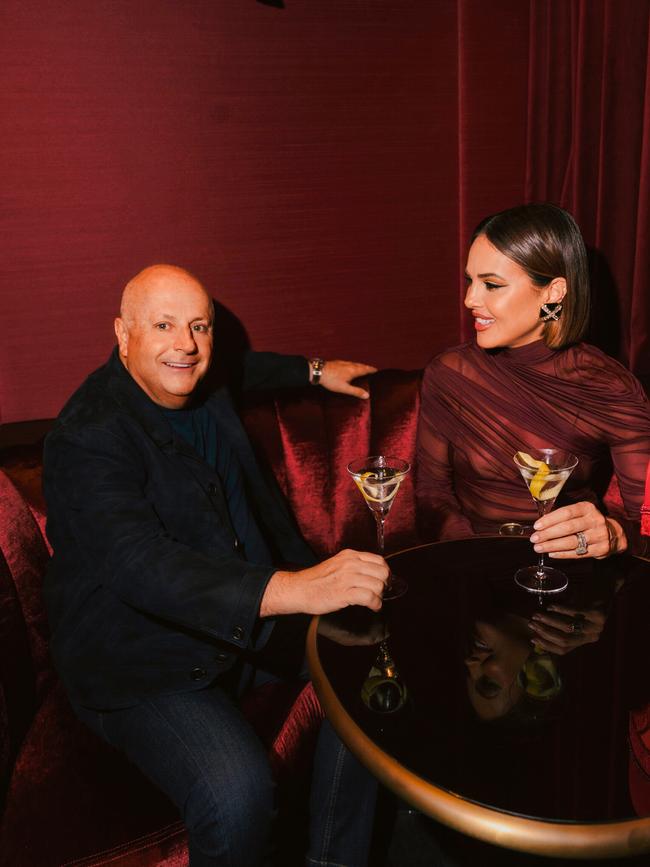
They were married in June 2023 at Aman Venice.
“One of our first few trips we went on, Chris wanted to take me to the most romantic cities in the world,” continues Sarah. “Isn’t that a good strategy?” smiles Chris. “Can you see why I married him?” continues Sarah.
“I picked the four most beautiful places to have dinner,” Chris adds of the trip to Paris’s Restaurant le Meurice Alain Ducasse, Splendido in Portofino, San Pietro in Positano, and The Gritti Palace in Venice, where he proposed.
“Then, I was thinking to myself, ‘She better say yes. It cost me a fortune!’.”
The hospitality world was never far from Chris’s sights growing up, with his father a chef and publican. “Food and hospitality is in my DNA, always wanting to please, I guess? I diverted out of it for a period of time … I went into marketing, lived in Tokyo during my first marriage and then I got drawn back in because it’s a passion. It’s just that my father never wanted me to be in it because it was such a hard business back then. It wasn’t a fun and glamorous business.”
“It’s like fashion,” interjects Sarah. “My mother never wanted me to do fashion,” she says of her equally glamorous mother who was a designer for Georges department store, a Melbourne institution.
“I think that’s where I sort of fell in love with design. All I wanted to do was be a fashion designer or an architect. And Mum was like, ‘Fashion is so cut-throat. You’ve got the marks, do a business degree and then let’s think about it’.” Sarah dutifully did a business degree at Monash University, but fashion remained her enduring love.
Art is another shared passion, and has always been a point of deliberate provocation in all of Chris’s restaurants.
“I do like to be thought-provoking because it gives people a talking point. I mean, restaurants are places where people are meant to have an opinion, everyone has an opinion about food. It’s an opinion-based business. I say, ‘Please be my guest’,” says Chris.
In his Society restaurant there’s a tapestry by Australian artist David Noonan, while for Kisumé, Chris commissioned a number of Polly Borland works as well as the Geisha series by controversial Japanese artist Nobuyoshi Araki.
“I think we’ve been a bit daring. Araki is not what you generally see in a dining space.”
For Maison Bâtard they acquired two major pieces by French artist Claire Fontaine from Mennour gallery in Paris.
“We spent a few weeks there looking at different galleries,” says Sarah, who had Melbourne creative director and friend Fabio Ongarato in tow. “That’s not a job for me!,” she says.
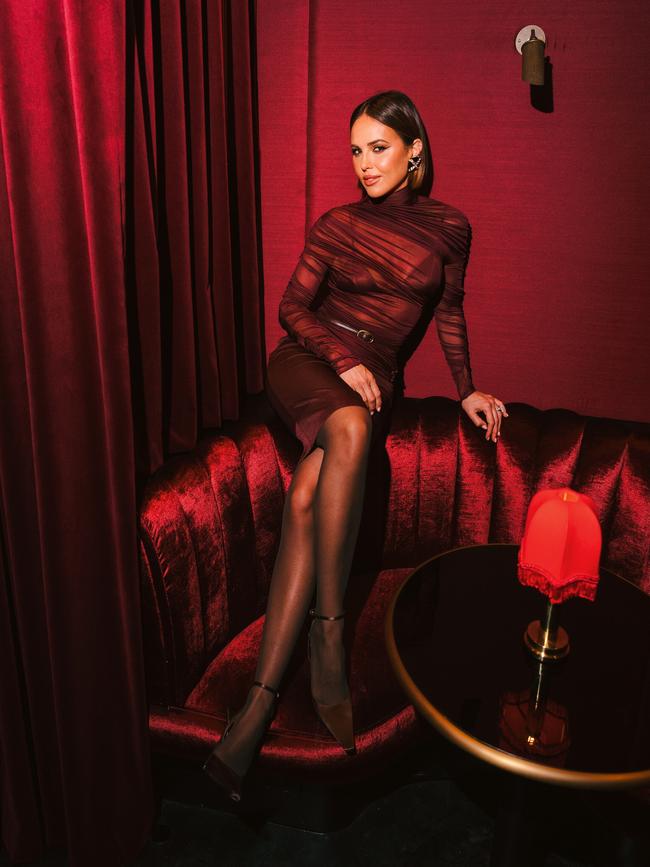
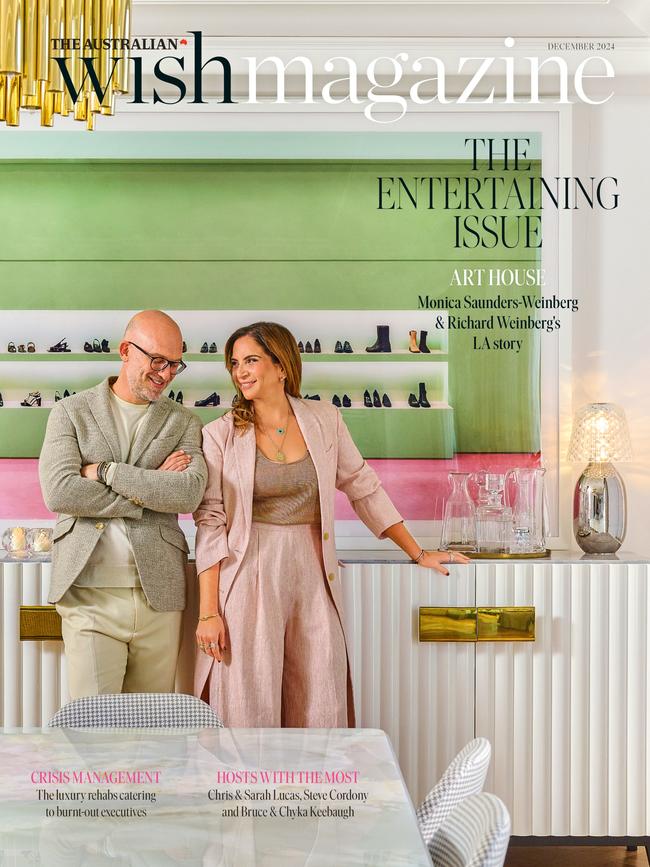
They came across Fontaine’s series – fashion fans will note the artist collaborated on Dior’s autumn/winter ’20-’21 show – of classical paintings with a contemporary edge. They fit perfectly with her design brief.
Now that Maison Bâtard’s dining offering – including its elegant rooftop terrace set around a 50-year-old maple tree – is in full flow, Le Club, the basement supper club, is set to be the city’s hottest ticket for its opening on New Year’s Eve.
“We were already digging a hole, so I said, ‘Let’s make it bigger and create a glamorous ’50s cabaret club’,” says Chris. “It’s all red velvet curtains, a grand piano, very turn-of-the-century, a little bit boudoir with a 3am license.
“Everything is custom designed by Sarah – all the little tables, all these sexy booths. Standing up is so uncool,” he laughs.
“We will be serving supper in the evenings. We’ll have a little Champagne trolley, caviar going on. You might get a pianist, you might get a vocal singer, you might get a violinist, you might get a little jazz group.”
“That really is something we think people will enjoy and we don’t have,” adds Sarah.
But these two won’t be on the dance floor for long. There is a second, French-inspired restaurant to come in Canberra in 2025 and perhaps also another dream to be realised. “The other thing I’ve always wanted to open is a hotel,” smiles Chris. “But a small, mini La Reserve,” he adds of the couple’s preferred Paris stay. “And to be honest, if this building allowed it, it would’ve been potentially a little hotel.”
Let’s all hope another site comes up nearby.
Photography: Jack Henry
Styling: Elliott Garnaut
This story is from the December issue of WISH.





To join the conversation, please log in. Don't have an account? Register
Join the conversation, you are commenting as Logout